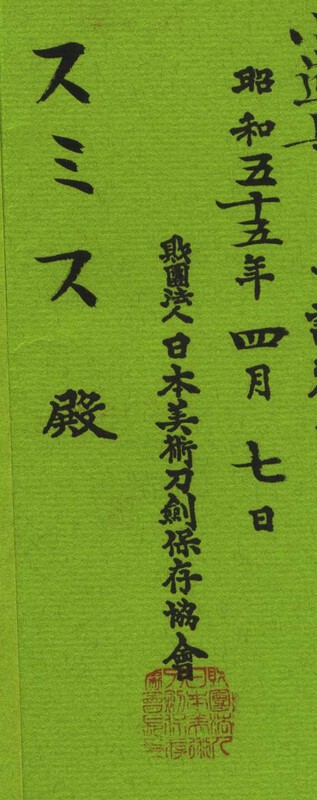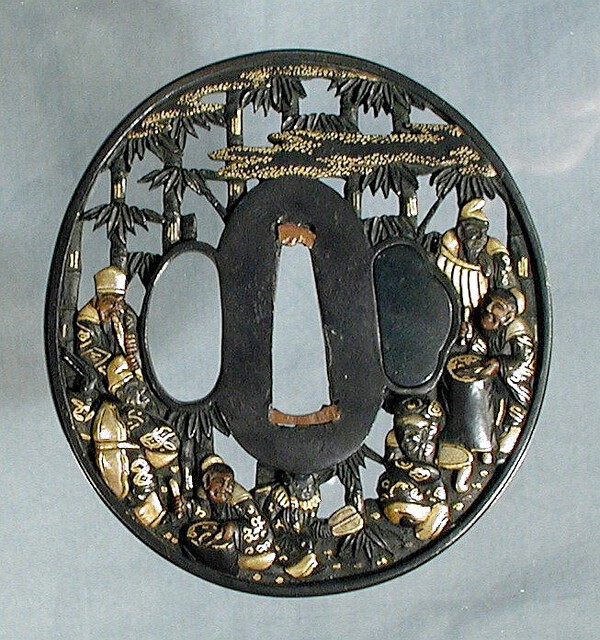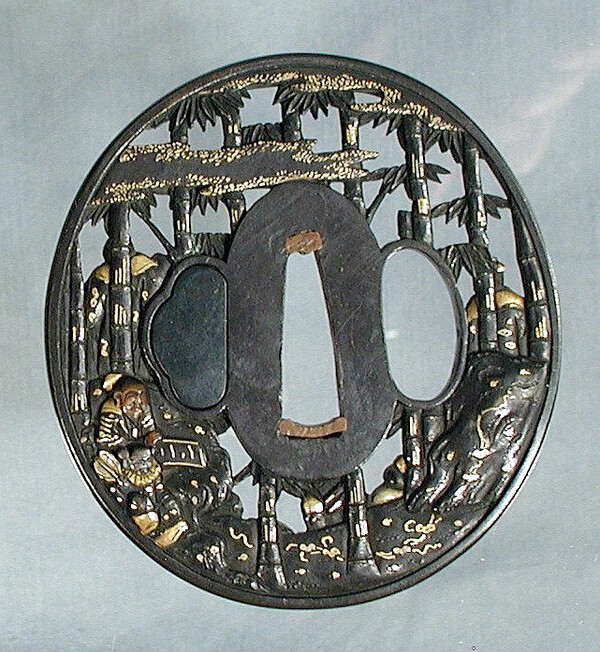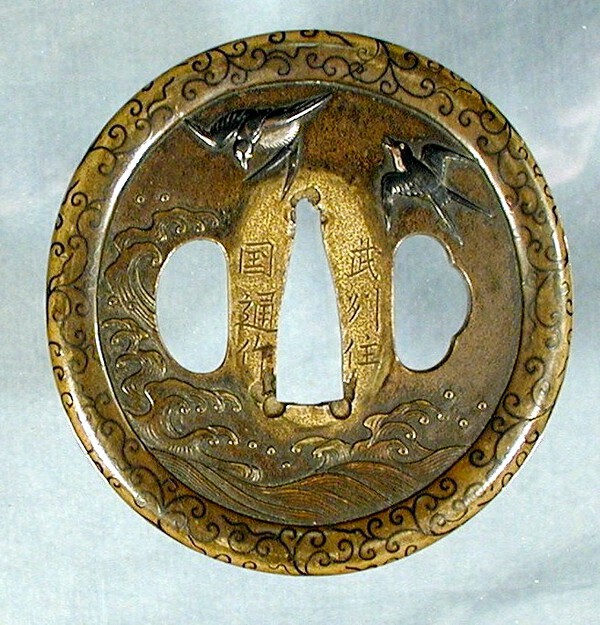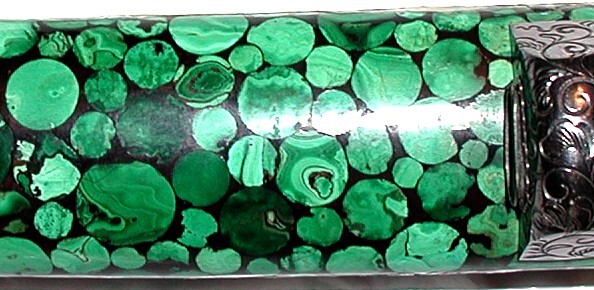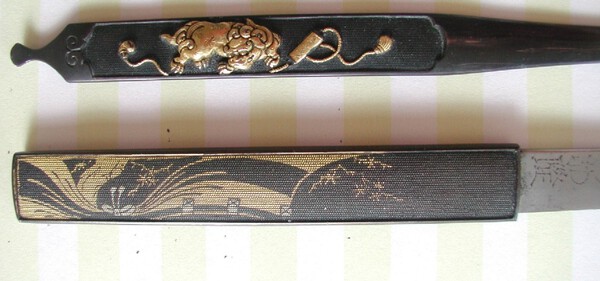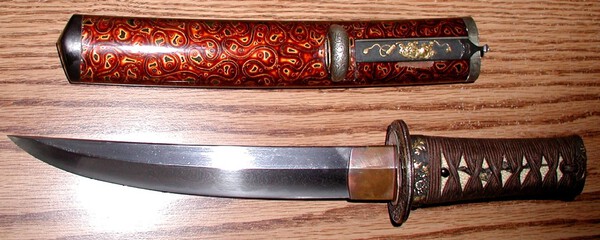-
Posts
703 -
Joined
-
Last visited
-
Days Won
4
Content Type
Profiles
Forums
Events
Store
Downloads
Gallery
Everything posted by Ron STL
-
Interesting to see this type of extention method. The only time I've ever seen a nakago "extended" was on a wonderful large Soshu wakizashi and that was at least 30-odd years ago. The sword was signed: Soshu ju Hiromasa and in polish with Soshu-style horimono. It's nakago was extended by affixing a copper sleeve to the typically short Shoshu nakago. There were no pins or rivets showing, so the sleeve must have been pressed on so as not to damage the nakago. You can see from the attached oshigata where the copper sleeve extention started. I very, very much wanted this sword but the owner, an Colonel in the AF working in St. Louis, was not interested in selling. He had brought this sword and a very large mumei naginata back from Japan as a teenager; his father was also military. I did make oshigata of his two blades and also took them to shinsa for him. Now retired to Sacramento, who knows, maybe one day... Ron STL
-
Ah, Smith...you're correct, Chris. This tsuba is part of the koshirae for my Soshu-style Naokatsu katana that I purchased from the widow of my friend, Rad Smith, after he died. Obviously Rad had the tsuba papered. I was never really excited about the tsuba but the sword is super quality. Rina was kind enough to put it aside for me, thanks to Rad's notes. All so long ago... Ron STL
-
I'm not so sure I agree with a mei being removed, but always open minded. I know (or think I know) that you see some tosogu signed only with a kao. As for the paper, I should have included the full paper...but does this explain where this shinsa was held? I realize this is where an owner's name goes but this looks more like initials for an event. Simple kanji but hey, I make no sense of them. Ron STL
-
This a two-part question regarding a kinko tsuba depicting Raijin, god of lighting. The tsuba is signed only with a kao as you can see from the photo. It carries an NBTHK "green paper" origami from 1980. From what I can tell the paper only mention (kao) and then, I would guess, a description of the tsuba...but no mention of who this maker was. Can someone confirm this for me? My other related question is, the origami is stampledat the bottom: B.S.g.h.896. I'm unfamiliar with this and wonder if anyone can explain this to me. I don't recall any stateside NBTHK shinsa in 1980 (Showa 55). Thanks Ron STL
-
Some very good informatin contributed here, indeed. It's no wonder some confusion, or should I say lack of a "black and white" answers, persist with Jingo works. With the case of my tsuba it would seem more appropriated to say 2nd or 3rd and leave it at that. My plan is to include this tsuba as one of my selection for the 2013 KTK catalogue, my reason for trying to describe it with some knowledge while not embarrasing myself. Again, great imput here, guys! Ron STL
-
Curran, I'm glad you also noticed the oddly made "hole" on these tsuba. I can only think the maker was feeling very "creative" about this when he made these, all part of what creates art over simply "a tsuba." You are correct about the silver wire being particularly bright. I feel confident (knowning where the tsuba came from) that nothing was "polished," so it must be the silver make-up of the wire that it did not patinate dark. By the way, my question about the gold zogan pattern around this tsuba, I found an example in "Tsuba, An Aesthetic Study," p. 166, where it is called "squared half-chain (pattern)" by Haynes. I'll go with that for my records. Ron STL
-
Curran, here is a quick shot of the reverse side of the Jingo tsuba as you requested. Sorry for the less-than-perfect photography, but it'll serve its purpose. Looking at this tsuba and others in the books that have the "hole" in them, it's interesting to note that these are actually out-of-round and made slightly angled (so that looking straight down at them, they lean ever so slightly left to right). On Sasano's illustrated tsuba this hole is called a "water drop," understandably so on that particular tsuba. Just an interesting observation. I would had gone to Les Dorfman with the Jingo questions but I believe he has already headed to Japan for a pre-DTI vacation. My tsuba was examined by Mr. Kawabata a couple years ago which is where the Jingo II call most likely came from. I need to study more on Jingo; reading on the school, it seems confusing for me to grasp a good understanding of it. Of course it doesn't help that classic examples are difficult to study in-hand. Ron STL
-
Attached photo is of a very strong and beautiful Jingo tsuba thought to be the work of Jingo II. It measures 84 mm x 80 mm x 4 mm. While I do treasure this tsuba I must admit my weakness with Jingo tsuba. That said, any comments from Jingo connoisseurs are welcomed. Interestingly, the omote shows a 16 petal chrysanthemum while the ura shows a 12 petal one. Possible kantei point? One immediate question...what is a name for the repetitive design framing the tsuba? I wanted to say "key fret" but that's different. Ron STL
-
This is a Kinai design, if I'm correct. Surprised it is not signed so. Ron STL
-
This is a shakudo Soten, unsigned, that I was considering using for the 2013 KTK catalogue publication, but decided to go with something else. This tsuba has wonderful detail which has survived time. Sages in bamboo theme. Just sharing...comments always welcomed. Ron STL
-
Thanks for your comments, John. Before researching the maker of my tsuba my impression of it was something associated with Umetada group. Haynes mentions Kaga training (hirazogan) and I'll go with that call. Another reference, one I regret not buying when it was available early-on, was Kaga Taikan. It might be a good book to check for any reference to this Kunimichi. But of course if Haynes didn't come up with more references, most likely Hawkshaw is it. Always found this tsuba interesting in that it came from Santiago, Chile. That was a collection of over 700 tsuba! I managed to acquire a dozen or so before it all went to auction. My Santiago friend who was involved initially, said that one U.S. buyer bought it all. Ron STL
-
Thanks David, that was fast. If you have a minute more, since you have the book in front of you, can you see how close the two mei compare, book illustration vs my posted photo? Ron STL
-
G'day all - I am researching a lovely kinko tsuba in my collection (attached) signed: Bushu ju Kunimichi saku. I believe this would be Haynes H.03613.0 from all indications. Haynes mentions an example of this fellows work shown in the Hawkshaw catalogue, p.161, #2073, illus. pl. XXXIII, p.60. Unfortunately, I do not have a copy of this famous old catalogue. Any possibility one of you would have it and if so, if a scan of this Hawkshaw illustration might be available? There is a slight possibility that my tsuba is this same one, of course. This one came out of a large tsuba collection sold in Santiago, Chile about a decade ago. Thanks in advance... Ron STL
-
Thanks for solving this mystery. At first, I was doubtful about this being a mineral (Malachite, called "Kujaku-seki/ishi" in Japanese) but seeing the explanations and the examples referenced, I'm convinced. It always surprises me what these Japanese craftsmen could do. My friend who owns this wakizashi is taking it to the big Louisville, Kentucky, show this weekend, in case anyone on-line is attending the show. He will also visit the Frazier museum to see the Samurai exhibit which ends the end of this month; I mention this as a reminder. If anyone can post more examples of malachite on saya, please do so. It is a learning experience! Ron ST>
-
Hi all - A friend just brought over a wakizashi (non-descript wakizashi) with an interesting laquer technique on its saya. Personally, I do not recall ever seeing this style of lacquer before. Maybe it is not lacquer and is something else, but lacquer is my guess. Can anyone tell me what this is called? The handashi fitting on the saya are shakudo but look Meiji era to me and as I said, the blade is nothing to speak of. Ron STL
-
Thanks John. Good high definition photo, too. I may print a copy of the photo and use it at a library sword talk I'm to give this Saturday. Nanako always has fascinated me and to see it used this way, it may impress my listeners. Ron STL
-
Just a reminder to those of you within reach of Louisville, Kentucky. The Samurai exhibit at the Frazier History Museum will soon enter its final month and will close the end of Septermber. While attendance has reportedly been good, I haven't really heard much from the "sword world" of collectors. What a shame it would be to be within reach of the exhibit and then neglect to see the treasures exhibited. As I said...just a reminder in case this exhibit slipped your mind. Life does get busy at times. Ron STL
-
Hi folks...this is an old topic by now but I thought I'd share some comments with you from Bob Haynes via Elliott Long (shibuiswords.com). Here is what Bob had to say about this type of work: "Brocade inlay style, mostly made in Kyoto, rarely signed ca.1750-1800, a nanako artist 'Tour de Force', could be made by any great nanako-shi. The subject is a curtain that surrounds a general encampment area." Just sharing...Ron STL
-
I thought maybe seeing the little mumei tanto that sports this kogai looks like. Mumei blade that looks like early forging and hamon but only 7.6" of the tip of a once longer blade. Kogai is average-good quality as is the f/k (in Omori Teruhide style), etc. Owned by a local friend who wants $3,500 for it -- I hope this is okay to say that here? -- but I'm still reeling from handling the Bizen Kanemitsu daito at the SF show that is priced almost equal to my home. (What a fantastic sword that one is!!!) Ron STL
-
Thanks for pointing me to the Compton and Robinson examples. Amazing that I missed these! I just sat down with the discussionkozuka and studied it closely with a loop. I can clearly see a thin layer of gold overlay on the design that has definitely been punched into place by applying nanako. Looking closely, you can see the edge of the gold and in a couple places, you can see where thie gold has been lost on a raised dot of nanako. The broader areas look to be of a sheet of gold but thinking about this, maybe the sheet gold was layed into place and applied punch by punch. That would make sense, sort of like appying nunome-zogan. All of this makes me want to keep this little tanto that carries this kozuka! My friend wants to sell it for pretty much retail. Ah, a time to bring out some trade beads, perhaps! Ron STL
-
Thanks Geraint, Lance...and here I thought I'd seen most all of it. :D I do have the Compton sales books but haven't looked at them in ages; I'll check out tomorrow. Yoshioka...I'll have to remember that. Ron STL
-
Here is an interesting kozuka, shakudo, unsigned, that is finished in a manner I've never seen before. The design on it depicts a hung banner with some pine tree branches in he background. All of this is in a gold finish. It appears that after adding this design, the entire surface and design has been covered with nice quality nanako. I don't ever recall seeing this type of treatment ever before even in the books showing kozuka. Does anyone have any information on this kind of work or can direct me to another illustrated example? My guess is a late Edo product but it is well done and quite pleasing to see. The nanako makes the overall finish look almost like a textile print. Ron STL
-
Nakajima was a polisher sent over in the early 1960s to polish for the newly established JSS/US. The late Dr. Homma (NBTHK) was involved in his coming to the JSS/US because he was qualified to not only polish, but to make habaki and shirasaya. He was also qualified to judge items and even today on occasion, an old white stock certificate can be found with the JSS/US seal and name along with Nakajima's name. I wrote an article to commemorate the JSS/US 50th year. Here is something on when Nakajima came on board: ---------------- 1962 - A major goal of the Society was to bring a “trained and qualified” sword restorer to the United States to serve the membership. Dr. Homma was approached about this and after a search, recommended Mr. Muneyoshi Nakajima for this position. Mr. Nakajima was not only a fully trained and working Japanese polisher, he was also trained to make habaki, shirasaya and in wrapping tsuka. In 1962 Mr. Nakajima arrived in America and became the official polisher-restorer for the JSS/US. ---------------- I'm not positive that he ever made any swords. Ron STL
-
Wow, nice sword and nice polish! You are fortunate to be able to start your studies with such a beautiful, in-polish sword. There is a nice inexpensive soft-cover book on Gassan which gives great information from the early days up until today. Gassa Sadatoshi is still making swords in Japan, today. It looks like the ji-hada is brought out very well, something that will allow to really "see" the forging! Congratulations again...Ron H.
-
It has been interesting following this subject and Brian, I must compliment you for your logic with regards to the opinions of Bob Benson and Jimmy Hayashi. Will all this advice being thrown at you, you did not panic. And yes, I do remember the thrill of finding my first "real" sword and to realize it survived 350+ years! A wakizashi signed Rai Kunimitsu, it was in reality an early Shin-to of Osaka origin, but I loved it. Since you are new into this world of the older blades, best advice is to see (and handle if possible) as many in-polish, high quality swords as possible. The upcoming San Francisco show will have many such swords like that. One comment about having shinsa before polishing, I would say that is a good idea "if" the sword is not totally accepted as "as signed," if a signed sword. Thinking back, almost all of my polished swords were polished first, then put through shinsa, but I had the advice and opinion of somebody who had real knowledge of swords, John Yumoto in the early days, Tanobe san, Benson and after years of studying, I came to pretty well (definitely not totally) came to trust my own judgement as to what is a good signature and perhaps more important, what is high quality jigane and nie/nioi hataraki. And...after all those years I still get excited with handling a quality sword. Just chit-chat... Ron H.




